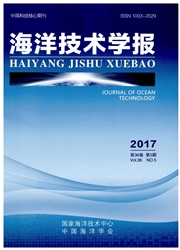

 中文摘要:
中文摘要:
渤海海冰是我国中高纬海域的重要海洋灾害之一。尝试利用静止气象卫星FY-2C资料对海冰在可见光、近红外、红外通道的辐射特性进行光谱分析,提出了遥感监测海冰的阈值检测定量判据0.1〈Rech5〈0.2,262 K〈Tbch1〈268 K,265 K〈Tbch4〈275 K,并结合发生在中国渤海海域的一次重大海冰灾害进行定量监测,监测结果的验证采用海冰实况进行对比分析。结果表明,可见光通道反照率是区分海水的有效特征,但海冰的反照率和晴空陆面及薄卷云有相似性,虽然可以利用红外通道亮温将晴空陆面剔除,近红外通道亮温却是剔除薄卷云的有效特征;该判据能够将海冰与云及海表分离开来,识别结果较好,可对海冰进行连续有效监测;此次分析虽然只是一个个例,但该技术对定量监测我国渤海湾海冰灾害的发生是一次很好的尝试。
 英文摘要:
英文摘要:
Sea ice in the Bohai Sea is one of the most serious marine disasters in China’s sea areas at the middle and high latitude, which poses significant effects on maritime affairs and navigation. The objective of the present work is to explore a method that can discriminate sea ice from clouds and ice-free ocean with hourly FY-2C multi-spectral data according to the radiance differences between water and ice respectively in the visible, nearinfrared and infrared channel. The quantitative threshold detecting criteria, 0.1 〈 Rech5〈0.2, 262 K 〈Tbch1〈268 K and 265 K〈Tbch4〈275 K, are presented for monitoring sea ice after collecting dataset and analyzing the spectral features. By quantitatively monitoring sea ice occurred in the Bohai Sea on 8 February 2006, the proposed technique is investigated, and the results of identification are validated by comparing with in-situ data. The results show that the albedo of the visible channel is the most effective characteristic to identify the sea ice from sea water type, and the albedo of sea ice is similar to that of clear land and cirrus. The brightness temperature of infrared channel is another feature to discriminate ice and cirrus from the clear land, despite the fact that it can be used to separate the sea ice from cirrus clouds. The algorithm based on the FY-2C data can discriminate sea ice from clouds and ice-free ocean in an accurate and effective way with a good identification result, capable of implementing continuous monitoring on sea ice. The proposed technique is proved to be a good approach to quantitatively monitor the occurrence of sea ice disasters in China’s Bohai Bay.
 同期刊论文项目
同期刊论文项目
 同项目期刊论文
同项目期刊论文
 期刊信息
期刊信息
